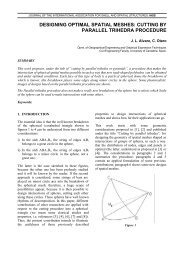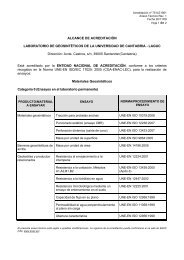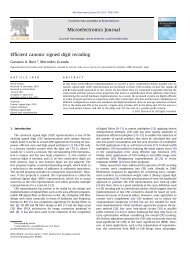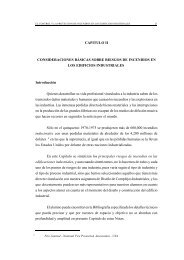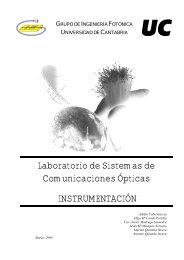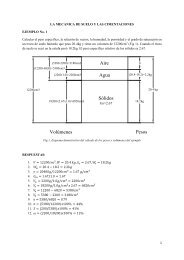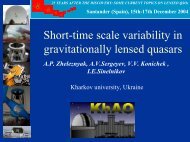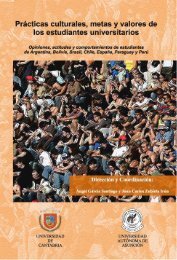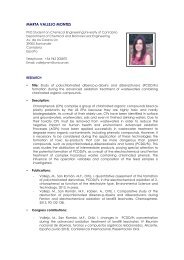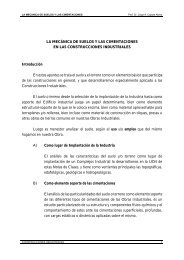XXXVII <str<strong>on</strong>g>IAHS</str<strong>on</strong>g><str<strong>on</strong>g>World</str<strong>on</strong>g> <str<strong>on</strong>g>C<strong>on</strong>gress</str<strong>on</strong>g> <strong>on</strong> <strong>Housing</strong>October 26 – 29, 2010, Santan<strong>de</strong>r, SpainCODE: 633THE DEMAND MANAGEMENT: A TOOL FORSUSTAINABILITY AND MAINTENANCE OF URBANINFRASTRUCTUREMichele Di Sivo and Daniela LadianaDepartment of Technology for Built Envir<strong>on</strong>mentUniversity “G. d’Annunzio” of Chieti and Pescarae-mail: mdisivo@unich.it; d.ladiana@unich.itKey words: Sustainability, urban maintenance, technological culture, tools, citizenAbstractThe challenge of city care involves assuming urban <strong>de</strong>velopment sustainability as the scenario withinwhich the a<strong>de</strong>quate levels of care, maintenance-c<strong>on</strong>servati<strong>on</strong> and c<strong>on</strong>sumpti<strong>on</strong> have to comparethemselves with <strong>de</strong>velopment aspirati<strong>on</strong>s, but at the same time the c<strong>on</strong>sumpti<strong>on</strong>/substituti<strong>on</strong> ofcapitals ma<strong>de</strong> of urban resources should be coherent with the exigency of maintaining naturalresources as well as those resources generated by anthropic acti<strong>on</strong>; such a challenge will have to bew<strong>on</strong> by i<strong>de</strong>ntifying new forms of urban policy, recognizing and enhancing the value of the role ofmaintenance for preserving the physical-natural-cultural heritage, by means of scientific processes ofplanning and c<strong>on</strong>trol and by carrying out a<strong>de</strong>quate acti<strong>on</strong> strategies.The Demand Management represents an important tool to achieve an urban infrastructure managementaiming at the optimizati<strong>on</strong> of the urban system life cycle and at the settlement sustainability.Such an approach is based <strong>on</strong> the assumpti<strong>on</strong> that infrastructure and urban service assets represent aresource whose use should be carefully planned and managed over time, avoiding a thoughtless usethat would accelerate the processes of <strong>de</strong>gradati<strong>on</strong> and resource <strong>de</strong>pleti<strong>on</strong> – because of an inefficientservice <strong>de</strong>livery or because of the c<strong>on</strong>structi<strong>on</strong> of a number of structures excessive if compared to thereal community needs. The policies of <strong>de</strong>mand management can affect the populati<strong>on</strong>’s percepti<strong>on</strong> andawareness of service need in or<strong>de</strong>r to give alternative answers which d<strong>on</strong>’t require any increases,replacements, or interventi<strong>on</strong>s within the existing infrastructure assets. All the possible outcomes ofsuch an approach are relevant both in ec<strong>on</strong>omical and envir<strong>on</strong>mental terms, since they d<strong>on</strong>’t <strong>on</strong>lyallow c<strong>on</strong>si<strong>de</strong>rable savings in investments in infrastructure re-qualificati<strong>on</strong> and/or replacement –whose need is postp<strong>on</strong>ed, but they also allow to significantly extend the system life cycles thanks tothe <strong>de</strong>crease in the use intensity and frequency. The <strong>de</strong>mand management policies operate within thecurrent cultural passage from a city populated with objects to a city structured with services, allowingto reduce the distance between the present mo<strong>de</strong>l of “city of quantity” and the <strong>de</strong>sired “city ofquality” structured and organized into a mainly immaterial form of growth.In such a <strong>de</strong>velopment scenario, the tools for urban management and maintenance are compared to thecategory of complexity, thanks to the adopti<strong>on</strong> of a systemic-like approach permitting to recognize andi<strong>de</strong>ntify the several relati<strong>on</strong>ships am<strong>on</strong>g the quality, sustainability and urban efficiency factors.37º <str<strong>on</strong>g>IAHS</str<strong>on</strong>g> <str<strong>on</strong>g>World</str<strong>on</strong>g> <str<strong>on</strong>g>C<strong>on</strong>gress</str<strong>on</strong>g> On <strong>Housing</strong> Science 253
XXXVII <str<strong>on</strong>g>IAHS</str<strong>on</strong>g><str<strong>on</strong>g>World</str<strong>on</strong>g> <str<strong>on</strong>g>C<strong>on</strong>gress</str<strong>on</strong>g> <strong>on</strong> <strong>Housing</strong>October 26 – 29, 2010, Santan<strong>de</strong>r, SpainCODE: 634URBAN RENEWAL IN COMPACT URBAN FABRICSJoão Grana<strong>de</strong>iro Cortesão i , F. Brandão Alves i , Joanne Patters<strong>on</strong> iiiCITTA – Research Centre for Territory, Transports and Envir<strong>on</strong>mentUniversity of Porto, Faculty of Engineeringe-mail: grana<strong>de</strong>irocortesao@gmail.com, alves@fe.up.ptiiiCardiff University, Welsh School of Architecturee-mail: patters<strong>on</strong>@cardiff.ac.ukKey words: urban heat island, microclimate, thermal comfort, urban renewal, urban <strong>de</strong>signAbstractC<strong>on</strong>temporary urban renewal is particularly aimed at promoting more pe<strong>de</strong>strian-focusedpublic spaces. Microclimate optimizati<strong>on</strong> is crucial to ensure the success of these acti<strong>on</strong>sc<strong>on</strong>si<strong>de</strong>ring summer thermal c<strong>on</strong>diti<strong>on</strong>s in temperate climates are increasingly stressed un<strong>de</strong>rthe urban heat island. In<strong>de</strong>ed, microclimate optimizati<strong>on</strong> will <strong>de</strong>termine human thermalcomfort and, c<strong>on</strong>sequently, the usage of public spaces and buildings.Un<strong>de</strong>r these circumstances, bioclimatic urban <strong>de</strong>sign premises should be incorporated intourban renewal programmes.This article presents the basis for a bioclimatic interventi<strong>on</strong> tool, illustrated by two casestudies in Porto (Portugal) and <strong>on</strong>e in Bristol (United Kingdom). The three outdoor spaces arelocated within compact urban fabrics. The case studies illustrate the importance thatcorrelating facing materials and vegetati<strong>on</strong> has <strong>on</strong> outdoors thermal comfort. Through thisrelati<strong>on</strong>ship, the combined effects of lower air and surface temperatures, higher air humidity,and lower levels of CO2 in the local atmosphere can be expected due to carb<strong>on</strong> sequestrati<strong>on</strong>by vegetati<strong>on</strong>. Additi<strong>on</strong>ally, CO2 emissi<strong>on</strong>s from buildings can be influenced. All of thechanges above promote more thermally comfortable outdoor spaces, therefore increasingpe<strong>de</strong>strian movements in urban spaces.The analysis of the Porto spaces, carried out through climatic measurements and inquiries toits users, was un<strong>de</strong>rtaken in or<strong>de</strong>r to assess their current microclimatic performance. A furthercomparis<strong>on</strong> of these spaces with the urban renewal case in Bristol is presented.It was found that differences in paving soluti<strong>on</strong>s and vegetati<strong>on</strong> levels between the first twospaces are causing a significantly different pattern of use from <strong>on</strong>e space to the other. On itsturn, the comparis<strong>on</strong> with the British space has shown the extent to which urban renewalprograms can be the opportunity to improve an outdoor space un<strong>de</strong>r a bioclimatic perspectiveand therefore increase its usage. The fundamentals of a simplified bioclimatic interventi<strong>on</strong>tool are thereafter suggested.37º <str<strong>on</strong>g>IAHS</str<strong>on</strong>g> <str<strong>on</strong>g>World</str<strong>on</strong>g> <str<strong>on</strong>g>C<strong>on</strong>gress</str<strong>on</strong>g> On <strong>Housing</strong> Science 254
- Page 1 and 2:
University ofCantabriawww.iahshousi
- Page 3 and 4:
ÍNDICE1. HONORARY COMMITTEE ______
- Page 5 and 6:
2. INTRODUCTIONThe International As
- Page 7:
4. ENTIDADES COLABORADORASColegio d
- Page 10 and 11:
6. ORGANIZING COMMITTEELOCAL ORGANI
- Page 12 and 13:
8. TOPICS - STATISTICSTOPIC I: MATE
- Page 14 and 15:
also the Spanish aristocracy used t
- Page 16 and 17:
11. CONFERENCE ROOMSThe Con
- Page 18 and 19:
Also, the Congress
- Page 20 and 21:
13. PLENARY SESSIONSPLENARY SESSION
- Page 22 and 23:
October 26, 9 h 30-10 h 00 (Room 0)
- Page 24 and 25:
October 26, 10 h 30-11 h 00 (Room 0
- Page 26 and 27:
October 27, 9 h 30-10 h 00 (Room 0)
- Page 28 and 29:
October 27, 10 h 30-11 h 00 (Room 0
- Page 30 and 31:
October 28, 9 h 30-10 h 00 (Room 0)
- Page 32 and 33:
October 28, 10 h 30-11 h 00 (Room 0
- Page 34 and 35:
October 26, 201011 h 30-13 h 30 Cha
- Page 36 and 37:
October 26, 201011 h 30-13 h 30 Cha
- Page 38 and 39:
October 27, 201011 h 30-13 h 30 Cha
- Page 40 and 41:
October 27, 201011 h 30-13 h 30 Cha
- Page 42 and 43:
October 28, 201011 h 30-13 h 30 Cha
- Page 44 and 45:
October 28, 201011 h 30-13 h 30 Cha
- Page 46 and 47:
16. TECHNICAL EXPOSITION (STANDS)37
- Page 48 and 49:
TRIP A: MARITIME MUSEUM + PEDREÑA
- Page 50 and 51:
RECEPTION COCKTAIL BY THE MAYOR OFS
- Page 52 and 53:
37º IAHS
- Page 54 and 55:
GALA DINNERDía 28 de OctubrePassin
- Page 56 and 57:
37º IAHS
- Page 58 and 59:
19. ABSTRACTS OF THE CONGRESSABSTRA
- Page 60 and 61:
XXXVII IAHS<strong
- Page 62 and 63:
XXXVII IAHS<strong
- Page 64 and 65:
XXXVII IAHS<strong
- Page 66 and 67:
XXXVII IAHS<strong
- Page 71 and 72:
XXXVII IAHS<strong
- Page 73 and 74:
XXXVII IAHS<strong
- Page 75 and 76:
XXXVII IAHS<strong
- Page 77 and 78:
XXXVII IAHS<strong
- Page 79 and 80:
XXXVII IAHS<strong
- Page 81 and 82:
XXXVII IAHS<strong
- Page 83 and 84:
XXXVII IAHS<strong
- Page 85 and 86:
XXXVII IAHS<strong
- Page 87 and 88:
XXXVII IAHS<strong
- Page 89 and 90:
XXXVII IAHS<strong
- Page 91 and 92:
XXXVII IAHS<strong
- Page 93 and 94:
XXXVII IAHS<strong
- Page 95 and 96:
XXXVII IAHS<strong
- Page 97 and 98:
XXXVII IAHS<strong
- Page 99 and 100:
XXXVII IAHS<strong
- Page 101 and 102:
XXXVII IAHS<strong
- Page 103 and 104:
XXXVII IAHS<strong
- Page 105 and 106:
XXXVII IAHS<strong
- Page 107 and 108:
XXXVII IAHS<strong
- Page 109 and 110:
XXXVII IAHS<strong
- Page 111 and 112:
XXXVII IAHS<strong
- Page 113 and 114:
XXXVII IAHS<strong
- Page 115 and 116:
XXXVII IAHS<strong
- Page 117 and 118:
XXXVII IAHS<strong
- Page 119 and 120:
XXXVII IAHS<strong
- Page 121 and 122:
XXXVII IAHS<strong
- Page 123 and 124:
XXXVII IAHS<strong
- Page 125 and 126:
XXXVII IAHS<strong
- Page 127 and 128:
XXXVII IAHS<strong
- Page 129 and 130:
XXXVII IAHS<strong
- Page 131 and 132:
XXXVII IAHS<strong
- Page 133 and 134:
XXXVII IAHS<strong
- Page 135 and 136:
XXXVII IAHS<strong
- Page 137 and 138:
XXXVII IAHS<strong
- Page 139 and 140:
XXXVII IAHS<strong
- Page 141 and 142:
XXXVII IAHS<strong
- Page 143 and 144:
XXXVII IAHS<strong
- Page 145 and 146:
XXXVII IAHS<strong
- Page 147 and 148:
XXXVII IAHS<strong
- Page 149 and 150:
XXXVII IAHS<strong
- Page 151 and 152:
XXXVII IAHS<strong
- Page 153 and 154:
XXXVII IAHS<strong
- Page 155 and 156:
XXXVII IAHS<strong
- Page 157 and 158:
XXXVII IAHS<strong
- Page 159 and 160:
XXXVII IAHS<strong
- Page 161 and 162:
XXXVII IAHS<strong
- Page 163 and 164:
XXXVII IAHS<strong
- Page 165 and 166:
XXXVII IAHS<strong
- Page 167 and 168:
XXXVII IAHS<strong
- Page 169 and 170:
XXXVII IAHS<strong
- Page 171 and 172:
XXXVII IAHS<strong
- Page 173 and 174:
XXXVII IAHS<strong
- Page 175 and 176:
XXXVII IAHS<strong
- Page 177 and 178:
XXXVII IAHS<strong
- Page 179 and 180:
XXXVII IAHS<strong
- Page 181 and 182:
XXXVII IAHS<strong
- Page 183 and 184:
XXXVII IAHS<strong
- Page 185 and 186:
XXXVII IAHS<strong
- Page 187 and 188:
XXXVII IAHS<strong
- Page 189 and 190:
XXXVII IAHS<strong
- Page 191 and 192:
XXXVII IAHS<strong
- Page 193 and 194:
XXXVII IAHS<strong
- Page 195 and 196:
XXXVII IAHS<strong
- Page 197 and 198:
TOPIC IV - HEALTH, COMFORT AND SAFE
- Page 199 and 200:
XXXVII IAHS<strong
- Page 201 and 202:
XXXVII IAHS<strong
- Page 203 and 204:
XXXVII IAHS<strong
- Page 205 and 206: XXXVII IAHS<strong
- Page 207 and 208: XXXVII IAHS<strong
- Page 209 and 210: XXXVII IAHS<strong
- Page 211 and 212: XXXVII IAHS<strong
- Page 213 and 214: XXXVII IAHS<strong
- Page 215 and 216: XXXVII IAHS<strong
- Page 217 and 218: XXXVII IAHS<strong
- Page 219 and 220: XXXVII IAHS<strong
- Page 221 and 222: XXXVII IAHS<strong
- Page 223 and 224: XXXVII IAHS<strong
- Page 225 and 226: XXXVII IAHS<strong
- Page 227 and 228: XXXVII IAHS<strong
- Page 229 and 230: XXXVII IAHS<strong
- Page 231 and 232: XXXVII IAHS<strong
- Page 233 and 234: XXXVII IAHS<strong
- Page 235 and 236: TOPIC VI - URBAN AND CITY PLANNING.
- Page 237 and 238: XXXVII IAHS<strong
- Page 239 and 240: XXXVII IAHS<strong
- Page 241 and 242: XXXVII IAHS<strong
- Page 243 and 244: XXXVII IAHS<strong
- Page 245 and 246: XXXVII IAHS<strong
- Page 247 and 248: XXXVII IAHS<strong
- Page 249 and 250: XXXVII IAHS<strong
- Page 251 and 252: XXXVII IAHS<strong
- Page 253 and 254: XXXVII IAHS<strong
- Page 255: XXXVII IAHS<strong
- Page 259 and 260: XXXVII IAHS<strong
- Page 261 and 262: XXXVII IAHS<strong
- Page 263 and 264: XXXVII IAHS<strong
- Page 265 and 266: TOPIC VII - ECONOMY AND FINANCING P
- Page 267 and 268: XXXVII IAHS<strong
- Page 269 and 270: XXXVII IAHS<strong
- Page 271 and 272: XXXVII IAHS<strong
- Page 273 and 274: TOPIC VIII - MANAGEMENT SCHEMES AND
- Page 275 and 276: XXXVII IAHS<strong
- Page 277 and 278: XXXVII IAHS<strong
- Page 279 and 280: XXXVII IAHS<strong
- Page 281 and 282: XXXVII IAHS<strong
- Page 283 and 284: XXXVII IAHS<strong
- Page 285 and 286: XXXVII IAHS<strong
- Page 287 and 288: XXXVII IAHS<strong
- Page 289 and 290: XXXVII IAHS<strong
- Page 291 and 292: XXXVII IAHS<strong
- Page 293 and 294: XXXVII IAHS<strong
- Page 295 and 296: XXXVII IAHS<strong
- Page 297 and 298: XXXVII IAHS<strong
- Page 299 and 300: XXXVII IAHS<strong
- Page 301 and 302: XXXVII IAHS<strong
- Page 303 and 304: XXXVII IAHS<strong
- Page 305 and 306: XXXVII IAHS<strong
- Page 307 and 308:
XXXVII IAHS<strong
- Page 309 and 310:
XXXVII IAHS<strong
- Page 311 and 312:
XXXVII IAHS<strong
- Page 313 and 314:
XXXVII IAHS<strong
- Page 315 and 316:
XXXVII IAHS<strong
- Page 317 and 318:
XXXVII IAHS<strong
- Page 319 and 320:
XXXVII IAHS<strong
- Page 321 and 322:
XXXVII IAHS<strong
- Page 323 and 324:
XXXVII IAHS<strong
- Page 325 and 326:
XXXVII IAHS<strong
- Page 327 and 328:
XXXVII IAHS<strong
- Page 329 and 330:
XXXVII IAHS<strong
- Page 331 and 332:
XXXVII IAHS<strong
- Page 333 and 334:
XXXVII IAHS<strong
- Page 335 and 336:
XXXVII IAHS<strong
- Page 337 and 338:
XXXVII IAHS<strong
- Page 339 and 340:
XXXVII IAHS<strong
- Page 341 and 342:
XXXVII IAHS<strong
- Page 343 and 344:
XXXVII IAHS<strong
- Page 345 and 346:
XXXVII IAHS<strong
- Page 347 and 348:
XXXVII IAHS<strong
- Page 349 and 350:
XXXVII IAHS<strong
- Page 351 and 352:
XXXVII IAHS<strong
- Page 353 and 354:
XXXVII IAHS<strong
- Page 355 and 356:
XXXVII IAHS<strong
- Page 357 and 358:
XXXVII IAHS<strong
- Page 359 and 360:
XXXVII IAHS<strong
- Page 361 and 362:
XXXVII IAHS<strong
- Page 363 and 364:
XXXVII IAHS<strong
- Page 365 and 366:
XXXVII IAHS<strong
- Page 367 and 368:
XXXVII IAHS<strong
- Page 369 and 370:
XXXVII IAHS<strong
- Page 371 and 372:
XXXVII IAHS<strong
- Page 373 and 374:
XXXVII IAHS<strong
- Page 375 and 376:
XXXVII IAHS<strong
- Page 377 and 378:
XXXVII IAHS<strong



